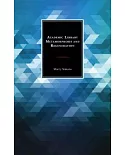Shortly after the syllabi are posted, and long before the beginning of the term, interlibrary loan departments at academic libraries will have filled or rejected innumerable textbook requests.
While it would be unwise if not impossible to buy and circulate every textbook at a college or university, there are many academic libraries who are selectively adding textbooks to their
collections. And the practice seems to be gaining momentum. In this volume, the Association for Library Collections and Technical Services (ALCTS) and editor Chris Diaz gather case studies that
pull together creative approaches and best practices for print textbook reserve programs. This book discusses such topics as results and analysis from a detailed survey of a state university’s
core-course textbook reserve program; funding sources for starting or piloting a program; using aggregated enrollment, grade, and textbook cost data to identify “high impact” courses;
identifying course-related books that are in the library’s collection or fit an existing collection policy; workflow for using bookstore data with ILS and purchasing systems; and using
LibGuides and Google Sheets to publicize textbook holdings, and how a back-end database supports discovery for students and reporting for reserves staff.A textbook reserve program can be one
way of helping students who are struggling with the high cost of textbooks, and this book spotlights a variety of examples that can be used as models.

















